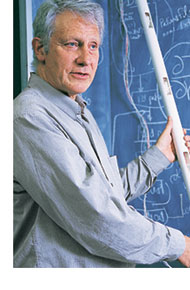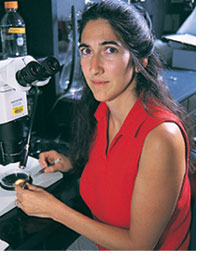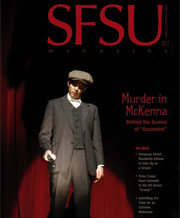                                 
| | Science 101 How SFSU Researchers Found Their Calling In labs, offices and far-flung locations, SFSU faculty are pursuing important research with major implications for the scientific world and the larger global community. While they are all experts in their subjects now, everyone had to start somewhere. SFSU Magazine asked a few of them, "What made your passion for science come alive?" Name: Wenshen Pong, Civil Engineering and Computer Science
Research: Professor Pong studies seismic dampers or methods for reducing the impact of earthquakes on buildings.
For Wenshen Pong, ending up as a civil engineer researching earthquakes in one of the world’s shakiest cities was a combination of natural ability, high school test scores, and good luck. In Pong’s native Taiwan, high school students are required to pick a "pre-major" by the age of 15 and spend the next three years focusing on their chosen field. Pong chose engineering but had no idea until his senior year placement exams came back that structural engineering would be his focus. And, it wasn’t until he met an American Fulbright scholar teaching at his alma mater that his fascination with earthquakes was born. After graduation, Pong received a scholarship to study at State University of New York Buffalo’s National Center for Earthquake Engineering, where he received both his M.S. and his Ph.D. His research in seismic dampers and energy dissipation devices has been applied to many major buildings including the new Moscone Center and the San Francisco International Airport.  Name: Megumi Fuse, Biology Name: Megumi Fuse, Biology
Research: Professor Fuse studies insect physiology in an effort to better understand nervous system functions and the regulation of complex behaviors.
As a high school student, Megumi Fuse was much more interested in playing the cello than having anything to do with bugs. Now this SFSU biologist can hardly contain herself when talk turns to insects. "Do you know there is a spider that can create an air bubble around itself so it can go under water?" she asks. "Or that the caterpillar degenerates and regenerates its nervous system and muscles to go from a worm-like structure to a winged creature?" She attributes this passion to a "super feisty" female biology teacher in high school. When she’s not teaching or helping her 3-year-old daughter feed their two pet Madagascar hissing cockroaches, Fuse can be found in her lab, where she uses insect models to research nervous system functions. Her studies on the neural regulation of complex behaviors, or how cells communicate and know what to do, have implications for all living things. Name: Roger Bland, Physics and Astronomy
Research: Professor Bland does underwater acoustical monitoring, collecting data about the acoustical communication of the blue whale.
Roger Bland majored in physics at Cal Tech in the ’60s because that’s what his physicist father wanted him to do. It turned out to be a fortuitous choice. By the time he was in graduate school studying particle physics at UC Berkeley, he was working with three different Nobel Prize-winning faculty members and loving the hunt for new matter in the universe. Now the physicist can be found recording and analyzing the calls of blue whales. His leap into something that more closely resembles behavioral biology than physics was mostly an opportunistic move. In 2001, some sophisticated underwater monitoring equipment at the Pioneer Sea Mount off Half Moon Bay became available. Bland jumped at the chance to use it. Since then, he and his research partner, Newell Garfield, an oceanographer at SFSU’s Romberg Tiburon Center, have collected more than 5,000 examples of the blue whale’s low, mournful call. While they’ve learned many interesting things about the communication of the blue whale (such as the fact that every whale has perfect pitch), they have yet to penetrate the mystery of what the whales are saying. They hope their research will someday be the key that helps scientists unlock that mystery.  Name: Carmen Domingo, Biology Name: Carmen Domingo, Biology
Research: Professor Domingo studies how cells begin to acquire specific fates in early development.
Carmen Domingo’s grandfather and uncle were both doctors with a passion for biology, so it is no surprise that she began her undergraduate career with the intention of becoming a physician herself. But working with an inspiring professor at UC Irvine, where she completed her bachelor’s degree, led her to change her plans. Examining the formation of the nervous system in chick embryos made her curious about how a simple fertilized egg can give rise to a complex organism. That curiosity was strong enough to convince her to forgo her medical career and pursue a Ph.D. in biology. Currently, Domingo studies cell differentiation in the African clawed frog. She says the frog is an ideal research subject because it can quickly produce many eggs which can be easily fertilized and studied in her lab. The professor’s studies may help scientists understand the full potential of human embryonic stem cells, which have important implications in the treatment of many diseases. Name: Arek Goetz, Mathematics
Research: Professor Goetz’s research involves piecewise isometric functions, an emerging field that may have practical uses in wireless phone technology.
Arek Goetz was so young when his interest in mathematics first emerged that he had to call his mother, a mathematics teacher, to help him remember how it all began. It was in his hometown of Wroclaw, Poland, and he was not quite 3 years old. His mother bought him some educational toys to help him learn how to add numbers whose sums were greater than 10. A year later, when he was asked why he stood alone in nursery school while the other children played, he reported that it was because he was busy doing multiplication tables for numbers less than 100 in his head. Today, Goetz is one of only about 40 people in the world researching piecewise isometric functions. Electrical engineers use piecewise isometries to model digital filters, which may help improve cell phone reception. Goetz’s research may help eliminate that much-asked question: "Can you hear me now?"  Name: Lisa White, Geosciences Name: Lisa White, Geosciences
Research: Professor White, department chair, guides graduate students in the research of fossils in extreme environments, such as hot springs and the deep sea.
Lisa White came to SFSU as an undergraduate wanting to study art and photography. To fulfill her science\ GE, she took a geology class. She had taken biology and astronomy and liked them but this class truly rocked her world. The course led to summer internships with the U.S. Geological Survey in Alaska and New Mexico, where White became intrigued with the field of paleontology. "It was just perfect because it was art and science rolled together," she says. "It’s a very visual science, where the observations you make are as important as the data you collect." Today, White is guiding and inspiring a new generation of rock hounds. She is principal investigator with Reaching Out to Communities and Kids with Science in San Francisco (SF ROCKS), a San Francisco State-based project aimed at increasing the number of students of color who enter college as geology majors. -- By Samantha Schoech 
|












 Name: Megumi Fuse, Biology
Name: Megumi Fuse, Biology
 Name: Carmen Domingo, Biology
Name: Carmen Domingo, Biology
 Name: Lisa White, Geosciences
Name: Lisa White, Geosciences